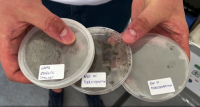How to grow cress on the moon
In the second half of July, the Swiss mountain Pilatus turned into a space colony, where students from all over the world tested solutions prepared for the IGLUNA project. Among them were young researchers from the Warsaw University of Technology - the creators of the plant breeding module in unfavorable conditions.
The IGLUNA project is a project of Space Innovations and the European Space Agency focused on the idea of space exploration. During the field campaign, student teams had the opportunity to test their technologies, incl. rovers and navigation systems. An original solution created by a team of students from Warsaw University of Technology - a self-sufficient module for plant breeding in lunar conditions - was also tested.
SAMPLE 2 (Semi-Autonomous Modular Plant and other Life-sustaining Experiment 2), as this is the name of the system created by our engineers, is a continuation of SAMPLE project prepared for the needs of last year's IGLUNA campaign.
Similarities and differences
“We use the same module that was built last year but of a modified version. In addition to heating, we have improved, among others a CO2 sensor and a light sensor that measures white light intensity and specific colours. For plants to grow, you need the right balance between red, blue and green”, says Gabriela Mystkowska, the student coordinating the technical aspects of SAMPLE 2.
The closed ecosystem inside each module is protected against extreme external conditions thanks to the use of thermal and radiation insulation. The energy needed to power the internal functions is provided by solar panels.
However, it is not the technical changes, but the biotechnological part that is the biggest revolution in the modified design. According to Konrad Uściło, the project's biotechnology section coordinator, the team decided to jump in at the deep end and act in line with the idea of terraforming. “We were able to buy a lunar soil simulator from Off Planet Research company. It is the best substrate simulating lunar regolith available for commercial use. Only NASA and other space agencies have access to better solutions,” explains our student. This niche product is characterized by an almost perfect structure, composition, density and chemical makeup, thus allowing it to work in "lunar conditions".
Casting for bacteria
Microorganisms also play a major role in the project, helping to transform the properties of the simulator in such a way that the plants for which the module is intended can grow effectively on it. When looking for the right bacteria, the students had to bear in mind the requirements of the lunar soil, and to make sure that it proves useful in the process of cosmic farming. The choice fell among others on the Shewanella oneidensis strain, which our students obtained from the Institute of Biochemistry and Biophysics of the Polish Academy of Sciences. - “In practice, it uses all the possible organic compounds, including CO2. It likes low pH, and also has a very interesting metabolism, which works well with a metallic substrate, it can reduce uranium, among others.”- Konrad Uściło lists the advantages of the bacteria.
SAMPLE 2 also uses, i. a., Cryptococcus albidius fungi that exude urease. They are able to break down urea, which in turn allows obtaining nitrogen compounds needed by plants. The strain is harmless to humans, nevertheless, it is recommended that people with reduced immunity should handle the module containing it with particular care.
A great test in the field
Our students tested their technology during a campaign on Mount Pilatus. After climbing and reaching an altitude of 2, 132 meters by an aerial tramway, they managed to install the module on a rocky, uneasy terrain. They could only control it remotely. The organizers planned to transfer data via the Internet with a 2.5-second delay to reflect the realities of controlling equipment in space.
After the field stage was completed and the module checked, the experiment proved a success. The combination of technical solutions with properly prepared regolith allowed the plants to germinate and - the students - to think seriously about continuing the project. This is the idea promoted by the team from Warsaw University of Technology that visited the Swiss Transport Museum. This is where the IGLUNA project control room was located, and SAMPLE 2 and other teams presented their technologies and answered the questions asked.
SAMPLE 2 team
- biotechnological part, Faculty of Chemistry, KNB ”Herbion” (Biotechnology Student Research Group ‘Herbion’) (scientific tutor: Joanna Cieśla, DSc, PhD, Associate Professor, Faculty of Chemistry)
- Konrad Uściło
- Zuzanna Lewandowska
- Michał Sawicki
- Anastasiia Hrunyk
- Karolina Olszewska
- Katarzyna Jankowska
- mechanical part, Student Space Association (scientific tutor: Jan Kindracki, DSc Eng. Associate Professor, Faculty of Power and Aeronautical Engineering)
- Magdalena Mącik
- Gabriela Mystkowska
- Patryk Sulej
- Ryszard Zawiła
More information about the event can be found on the sitehttps://space-innovation.ch/igluna.








